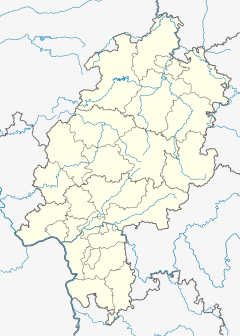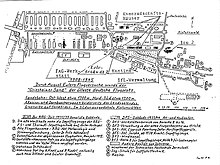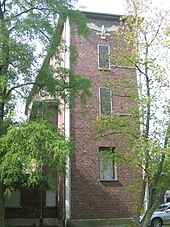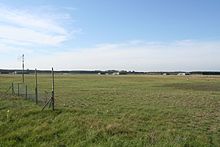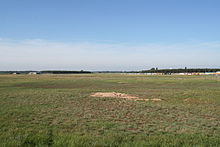August Euler Airfield
| August Euler Airfield | |
|---|---|

|
|
| Characteristics | |
| ICAO code | (formerly) EDES |
| IATA code | (formerly) ZCS |
| Coordinates | |
| Height above MSL | 160 m (525 ft ) |
| Transport links | |
| Distance from the city center | 1 km southeast of Griesheim |
| Street | Flughafenstrasse / Georgiiplatz |
| Basic data | |
| opening | 1908 by August Euler |
| operator | TU Darmstadt |
| surface | 70 ha |
| Start-and runway | |
| 07 | 1100 m × 20 m asphalt |
|
|
|||
|---|---|---|---|
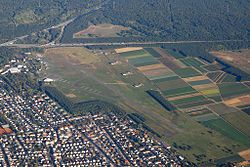
Aerial photograph (2011) |
|||
| country | Germany | ||
| Alternative names | Darmstadt Army Air Field (AAF), Griesheim Army Airfield, Griesheim Airfield, August Euler Airfield | ||
| local community | Darmstadt | ||
| Coordinates : | 49 ° 51 ' N , 8 ° 36' E | ||
| Opened | 1908/1999 (closed 1992/2008) | ||
| Formerly stationed units | |||
|
I. Group of Jagdgeschwaders 53 2nd Squadron of Night Squadron 11th 159th Medical Company (Air Ambulance) 421st Medical Battalion (Evacuation) 2040th Civilian Support Group (Ordnance) 1st Missile Battalion, 67th US Arty Group United States Navy ( US Navy Europe ) 233rd Base Support Battalion Stars & Stripes European Headquarters |
|
||
|
Location of the August Euler airfield in Hesse |
|||
The August-Euler-Flugplatz (also Griesheimer Sand Airfield ) is a special airfield located in the west of Darmstadt , or in the south of Griesheim , on the former Griesheim area. Between 1945 and 1992 it was referred to as "Darmstadt Army Airfield" or "Griesheim (Army) Airfield". It was named after the aviation pioneer August Euler , who founded the first German airfield and the first German aircraft factory here in 1908. It is the oldest airfield in Germany with a very traditional past.
history
After August Euler had founded the first German flying machine factory in October 1908, he leased the foot parade ground at the Griesheim military training area for his flight attempts and opened Germany's first airfield. At the beginning of 1909, Euler had an assembly hall built in which a total of 40 aircraft had been assembled by 1911. He also trained 75 pilots, mainly officers, in Griesheim and Frankfurt am Main from 1910 to 1918 . A pilot house was built next to the assembly hall. On October 25, 1910, Euler set a German long-term flight record from Griesheim with 3 hours, 6 minutes and 18 seconds. In January 1912 the Euler-Werke relocated to Schwanheim near Frankfurt a. M.
On October 1st, 1912, the Darmstadt airfield of the Prussian Army was officially opened. In 1911/12 a wooden aircraft hangar about 120 meters long and 21 meters wide was built. In 1913, the army administration had a further 160-meter-long steel aircraft hangar with a repair yard and the air barracks built, in which the 3rd company of the 3rd Air Battalion was housed from October 1, 1913. In February 1914 50 machines were already stationed. During the First World War , planes were repaired and flown in and a flight school was operated at the flying station. The Air Force Replacement Division No. 3 was set up from the stationed company when the war broke out. When the FEA 3 was relocated to Gotha in February, the pilot replacement department No. 9 was set up in Griesheim shortly afterwards, and it remained there until the end of the war.
In December 1918, the French army occupied the airport and banned flight operations.
After the French withdrew in June 1930, the airfield was re-established. The airship LZ 127 Graf Zeppelin landed here on August 3, 1930 . Two more landings followed on August 11, 1930.
From April 1, 1932, the city of Darmstadt leased the approximately 70 hectare airfield site from the German Reich for its new Darmstadt Airport , which replaced the Lichtwiese landing area in autumn 1934 . The Lufthansa , previously ten years Darmstadt had served, presented at the same time as the last transport airline flight operations to Darmstadt one.
In May 1933, the German Research Institute for Gliding (DFS) moved its institutes to the barracks at the airport. The buildings were repaired in 1934 and subsequently expanded. In the 1930s, shipyards, workshops and a wind tunnel were built here for the research facility. Another wind tunnel was built in 1936 for the Technical University of Darmstadt, which is still used today by the Technical University of Darmstadt (TU Darmstadt). Up to 780 employees were employed at DFS, including the staff from the Aviation Engineering School (IfL). Around 1936, Hans Jacobs (DFS) designed a number of well-known glider types, including the DFS Habicht , DFS Kranich , DFS Weihe and DFS 230 .
From October 1, 1937, on the instructions of the Hessian Reich Governor Jakob Sprenger, the airfield along with other areas was removed to Darmstadt.
The German Research Institute for Gliding was relocated to Braunschweig in 1939. The airfield was taken over by the Luftwaffe in the same year and designated as the second order port of operations Darmstadt-Griesheim. During the Second World War it was used as an air base. Group I of Jagdgeschwader 53 was stationed longer at the air base from December 1939 to May 1940 and the 2nd squadron of Nachtjagdgeschwader 11 from September 1944 to March 1945 . There were air raids on June 29, 1940 at 12:30 a.m., on the night of April 10th to 11th, 1943 and at noon on December 24th, 1944 during a major attack on Griesheim by the 3rd Bombardment Division of the 8th Air Force with 189 aircraft . Before their retreat on March 23, 1945, German troops blew up military installations and hangars.
After the Second World War, 1945, the August Euler Airfield was used by the United States Army and the base of a rescue helicopter squadron. The Sikorsky S-58 were in use in Griesheim during this time. Since 1987 the 159th Medical Company (Air Ambulance) [15 UH-60A Black Hawk ] was stationed here (set up in October 1987 from the 159th Medical Detachment). The 421st Medical Battalion (Evacuation) was relocated here in 1989 from Nellingen auf den Fildern (Ostfildern) (set up in October 1987 from the 421st Medical Company (Air Ambulance). Relocated in April 1989 to Darmstadt (GE), Griesheim AAF).
In 1964 the 2040th Civilian Support Group was relocated from a barracks in Münster to Griesheim to a small barracks on the CSG Compound on the edge of the August-Euler-Flugplatz. The group had a strength of 130 people. 48 of them were stationed in Griesheim.
The Hessen-Flieger Verein für Luftfahrt Darmstadt 1924 e. V. was allowed to use the airfield from 1974 to 1992. In spring 1992 "Darmstadt Army Airfield" with the ICAO code EDES was given up. With an order dated January 25, 1993, the Federal Ministry of Defense, as the competent military aviation authority, de-dedicated the airfield.
Since 1980 the area has been called “August-Euler-Flugplatz”. It has an asphalt runway with a length of 1100 meters and has belonged to the TU Darmstadt as a research open space since 2005 . The TU is the operator of the special airfield Griesheimer Sand and is still allowed to use it to a small extent for research purposes.
The US Army officially closed the Darmstadt site in 2008 and released an area of around 25 hectares north of the airfield, which is built on, among other things, with buildings for flight operations, administrative facilities, vehicle hangars, storage buildings and residential buildings. The property is to be sold.
US soldiers newspaper The Stars and Stripes
After the Second World War, the European headquarters of the American army newspaper The Stars and Stripes was housed in the former air barracks of the Darmstadt Aviation Station (from 1919, Caserne Garnier du Plessis and later the building of the German Research Institute for Gliding) on the Stars & Stripes Compound. This was in the immediate vicinity of August Euler Airport.
From 1949 to 2008 the European edition of The Stars and Stripes was printed there as a daily newspaper, which incidentally also appears on Sundays.
Nike firing position
As part of the air defense of Western Europe during the Cold War , the US armed forces were involved with a total of six battalions in the Nike Hercules anti-aircraft belt that ran across Germany . The 1st Missile Battalion, 67th US Arty Group, had atomic firing positions in Griesheim , Mainbullau , Hardheim and Dallau .
In the spring of 1957, the US Army began work on the stationing of three bases for anti-aircraft missiles of the Nike Ajax type . The Nike launch area in Griesheim was converted to Nike Hercules rockets in 1961 , which were armed with nuclear warheads . The Nike missiles were deployed until the late 1960s. The position was then rebuilt and used for non-nuclear HAWK anti-aircraft missiles until around 1983 . After the rocket battery was withdrawn, the facilities were dismantled. The three missile hangars and bunkers for the operating crews were on the southern side of the airport area and were preserved.
The rockets were monitored by the so-called Fire Control. This was located near the missiles.
Nature reserve
The airfield was almost completely protected in 1996 due to the dry sand grass and was reported to the European Union (EU) as a priority fauna-flora-habitat due to its special features and species population . In addition, the August Euler airfield is part of the European bird sanctuary " Griesheimer Sand ". Both areas belong to the EU's " Natura 2000 " network of protected areas .
Because agricultural use and fertilization did not take place due to the former use, the dry and barren terrain has been preserved as a rare sand ecosystem and now offers a habitat for numerous species that are endangered across Europe. The terrain consists mainly of calcareous sands.
Around a third of 100 bird species recorded are endangered. There are z. B. the milkweed hawk (nocturnal butterfly) or the wheatear . Of the 30 breeding pairs that are still known from the wheatear in Hesse, 10 pairs live here alone. Of the 80 grasshopper species that occur in Germany, 24 are native here (e.g. beautiful shrimp, wine-chickens ). Furthermore, rare large butterfly species (8 of them are on the red list ) and wild bee species (e.g. steppe bee) are among the inhabitants.
The biodiversity of the flora is also impressive. Here z. B. the carnation grass and the endangered blue shrub grasslands (mainly native to the Russian steppe). 23 endangered plant species grow here alone.
Antenna system
The US Army re-occupied a small area of the airfield in 2003. There, under the project name "ICEbox", four receiving and one transmitting dishes were set up, which, according to INSCOM, came from the former US-American ECHELON monitoring system Bad Aibling Station (BAS). The official name of the facility was "Navy Information Operations Detachments (NIOD) Griesheim, Germany".
The parabolic antennas were hidden under radomes , each 16 meters high and 7 meters in diameter. These dishes were connected to a small operations and satellite control building on the site. There were at least two other "ICEbox" stations in Misawa, Japan and at Buckley Air Force Base in Colorado.
A location on Eberstädter Weg was planned for the antenna systems, but this was not done because an FFH area would have been affected, the city of Griesheim was informed on July 9, 2003. In 1999, the United States Army Intelligence and Security Command (INSCOM) established a headquarters on Eberstädter Weg, known as the Dagger Complex . Operation of the antennas began on April 1, 2004. Between 2006 and 2008, the antennas were operated remotely from Wiesbaden. There is the headquarters of the US Army Command in Europe ( USAREUR ). In the period from 2008 to 2010, the radomes and their foundations were dismantled.
For the secret service expert Erich Schmidt-Eenboom , the antenna system was part of Echelon. The German Peace Council speaks of recording (opposing) information to support military operations, but probably also to monitor political opponents and industrial espionage. In an article in the American Army newspaper The Stars and Stripes in 2003, it was denied that the relocation of the 66th Military Intelligence Brigade to Griesheim in the aforementioned Dagger Complex was connected with the construction of the satellite dishes. Rather, it was a United States Navy (US Navy Europe) facility .
Historical buildings
literature
- Ursula Eckstein: August Euler Airfield Darmstadt . Justus von Liebig Verlag, Darmstadt 2008, ISBN 978-3-87390-255-8 .
- Monument topography Federal Republic of Germany . Cultural monuments in Hessen. City of Darmstadt. Vieweg, Braunschweig 1994, ISBN 3-528-06249-5 .
- Andreas Göller, Annegret Holtmann (ed.): A century of aviation history between tradition, research and landscape management. The August Euler Airfield in Darmstadt-Griesheim. Scientific Book Society, Darmstadt 2008, ISBN 978-3-534-22153-0 .
Web links
Individual evidence
- ↑ a b BFU investigation report CX007-0 / 00 of January 2002 on the accident on August 9, 2000 with information on the airfield on page 5
- ↑ http://www.dfg-vk-darmstadt.de/Lexikon_Auflage_2/AugustEulerFlugplatz.htm
- ↑ a b Ursula Eckstein: August-Euler-Flugplatz Darmstadt. Justus von Liebig Verlag Darmstadt 2008, p. 248
- ↑ http://www.usarmygermany.com/Units/Army%20Aviation/Partials_Griesheim%202.htm
- ↑ a b Public invitation to tender VOB / A for the demolition work. (No longer available online.) Hessisches Baumanagement (HBM), July 24, 2009, archived from the original on March 4, 2016 ; Retrieved July 14, 2013 . Info: The archive link was inserted automatically and has not yet been checked. Please check the original and archive link according to the instructions and then remove this notice.
- ↑ a b Standard data sheet excerpt for VR area: 6117-304 "Former August-Euler-Flugplatz von Darmstadt" ( page no longer available , search in web archives ) Info: The link was automatically marked as defective. Please check the link according to the instructions and then remove this notice.
- ↑ Ursula Eckstein: August Euler Airfield Darmstadt. Justus von Liebig Verlag, Darmstadt 2008, p. 28.
- ↑ Germany's oldest airfield turns 100 - anniversary event with a large air show. Press release from TU Darmstadt on August 14, 2008.
- ↑ Ursula Eckstein: August Euler Airfield Darmstadt. Justus von Liebig Verlag, Darmstadt 2008, p. 36.
- ↑ Ursula Eckstein: August Euler Airfield Darmstadt. Justus von Liebig Verlag, Darmstadt 2008, p. 41.
- ↑ https://frankfurt.de/sixcms/detail.php?id=2855&_ffmpar%5B_id_inhalt%5D=2603664
- ↑ Ursula Eckstein: August Euler Airfield Darmstadt. Justus von Liebig Verlag, Darmstadt 2008, p. 73.
- ↑ Bundesarchiv ( page no longer available , search in web archives ) Info: The link was automatically marked as defective. Please check the link according to the instructions and then remove this notice.
- ↑ a b c Lexicon "From Adelung to Forced Labor", 2nd edition. German Peace Society-United War Service Opponents e. V., August 12, 2013, accessed August 19, 2013 .
- ↑ Ursula Eckstein: August Euler Airfield Darmstadt. Justus von Liebig Verlag, Darmstadt 2008, p. 190.
- ^ Wind tunnel of the TU Darmstadt. Technische Universität Darmstadt, 2013, accessed on July 14, 2013 .
- ↑ 100 years of August-Euler-Flugplatz - anniversary celebration on 30./31. August 2008. Technische Universität Darmstadt, 2008, accessed on August 19, 2013 .
- ↑ The US Armed Forces in Europe 1989, p. 129. (PDF; 1.2 MB) OW Dragoon, November 2012, accessed on August 19, 2013 (2nd edition).
- ↑ 2040th CSG (Ord) - Stars & Stripes Compound. usarmygermany.comg, 2013, accessed August 22, 2013 .
- ↑ Ursula Eckstein: August Euler Airfield Darmstadt. Justus von Liebig Verlag, Darmstadt 2008, p. 226.
- ↑ Archive link ( Memento of the original dated May 16, 2013 in the Internet Archive ) Info: The archive link was inserted automatically and has not yet been checked. Please check the original and archive link according to the instructions and then remove this notice. Technische Universität Darmstadt, Hessian Society for Ornithology and Nature Conservation e. V .: August-Euler - An airfield for nature
- ↑ Archived copy ( Memento of the original dated January 3, 2014 in the Internet Archive ) Info: The archive link was automatically inserted and not yet checked. Please check the original and archive link according to the instructions and then remove this notice.
- ↑ Ursula Eckstein: August Euler Airfield Darmstadt. Justus von Liebig Verlag, Darmstadt 2008, p. 227
- ↑ Riedbahn Darmstadt - Goddelau, integrated into war logistics, documentation. Walter Kuhl, 2013, accessed August 24, 2013 .
- ↑ 2040th CSG (Ord) - Stars & Stripes Compound. In: usarmygermany.com. 2013, accessed August 22, 2013 .
- ↑ Frank W. Methlow: "Stars & Stripes" leaves Südhessen. In: Frankfurter Rundschau. September 22, 2008, archived from the original on March 4, 2016 ; Retrieved July 14, 2013 .
- ↑ Reference Guide No. 16, The American Military Presence and Cicil-Military Relations in Germany, A Guide to Sources in American and German Archives. (PDF; 671 kB) (No longer available online.) German Historical Institute, Washington, DC, archived from the original on September 14, 2013 ; Retrieved August 24, 2013 . Info: The archive link was inserted automatically and has not yet been checked. Please check the original and archive link according to the instructions and then remove this notice.
- ↑ Dallau former nuclear weapons location, Germany. International Doctors for Nuclear War Prevention (IPPNW), 2013, accessed July 14, 2013 .
- ↑ Ursula Eckstein: August Euler Airfield Darmstadt. Justus von Liebig Verlag, Darmstadt 2008, p. 239.
- ↑ Griesheim. (No longer available online.) International Doctors for Nuclear War Prevention (IPPNW), September 2010, archived from the original on July 19, 2013 ; Retrieved July 14, 2013 . Info: The archive link was inserted automatically and has not yet been checked. Please check the original and archive link according to the instructions and then remove this notice.
- ↑ Missile positions in Griesheim. on: bimbel.de
- ↑ US Army installations: Darmstadt
- ↑ Email from Wayne Gutshall. In: usarmygermany.com. 2013, accessed July 14, 2013 .
- ↑ The airfield as a flora-fauna habitat. (No longer available online.) Technische Universität Darmstadt, 2013, archived from the original on December 4, 2013 ; Retrieved August 20, 2013 . Info: The archive link was inserted automatically and has not yet been checked. Please check the original and archive link according to the instructions and then remove this notice.
- ^ A b Hans-Peter Richter: (Foreign) military bases in Germany. (PDF; 161 kB) German Peace Council, August 16, 2007, accessed on August 23, 2013 .
- ^ Ward Sanderson: Communications relay facility worries residents of German town. Stars and Stripes, April 1, 2004, accessed September 2, 2013 .
- ↑ pg: Operation "Icebox" - The balls are here! (PDF; 174 kB) In: Griesheimer Anzeiger. March 27, 2004, accessed July 14, 2013 .
- ^ Spring 2003 edition of the INSCOM Journal. (PDF; 1.0 MB) INSCOM , March 1, 2003, accessed on July 14, 2013 .
- ↑ Florian Rötzer : Will the Echelon eavesdropping system in Germany be preserved? Telepolis , March 22, 2004, accessed July 14, 2013 .
- ↑ wb: US satellite system from Bad Aibling is installed on the Euler airfield. (PDF; 278 kB) In: Griesheimer Anzeiger. October 1, 2003, accessed July 14, 2013 .
- ^ Naval Security Group Station History. Naval Security Group, July 13, 2008, accessed September 2, 2013 .
- ↑ ECHELON station Griesheim near Darmstadt. In: hp.kairaven.de
- ^ A b Matthew Aid : The European Cryptologic Center at Darmstadt, Germany. In: tumblr.com , July 22, 2013
- ↑ a b German Peace Society ( online )
- ↑ Ursula Eckstein: August Euler Airfield Darmstadt. Justus von Liebig Verlag, Darmstadt 2008, p. 233.
- ^ Klaus Eichner: Friendship services background. On the history of American-German relations in the field of electronic warfare (Part II and conclusion). In: Junge Welt. August 8, 2013, accessed August 22, 2013 .
- ^ A. Arnold: Army dismantles listening systems. Controversial radars should be gone by the end of the year. "Part of the US war machine". In: Frankfurter Rundschau. June 30, 2007, accessed July 14, 2013 .
- ↑ References Linkamp GmbH. Linkamp GmbH, 2010, accessed on July 14, 2013 .
- ↑ "The radomes will grow" - secret service expert Schmidt-Eenboom: "Icebox" is definitely part of the Echelon interception system. (PDF, 168 kB) In: Griesheimer Anzeiger. April 3, 2004, accessed July 14, 2013 .
- ^ Charlie Coon: 66th MIG assets to begin moving to Darmstadt. The Stars and Stripes , October 7, 2003, accessed July 14, 2013 .
- ↑ Jessica Iñigo: German community addressed about communication facility. The Stars and Stripes , November 20, 2003, accessed July 14, 2013 .
